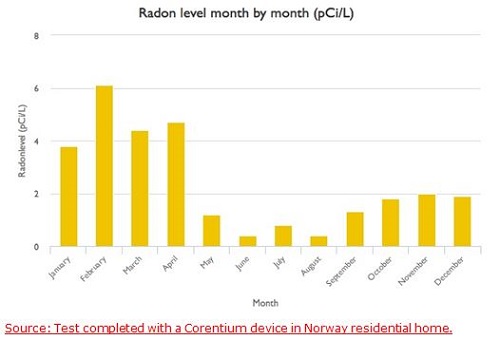 |
> Inspector E&O Insurance: OREP Invites You to Compare Coverage & Rates (get ready to smile) > InspectorAdvisor: Get Your Tough Inspection Questions Answered by a Pro |
Redefining Radon Testing
By Oyvind Birkenes, CEO Airthings
Right now across the United States, people are jeopardizing their health simply by breathing the air in their homes. The culprit? Radon, the colorless, odorless radioactive gas that acts as a silent and stealthy killer.
In the United States, there is a severe lack of awareness about radon. Currently, most conversations about radon occur during times of buying and selling homes. But because radon levels change and consistent monitoring is the only way to determine if levels in the home are safe, we need to talk about the problem and solution much more frequently.
What is Radon?
Radon enters a home, new or old, by seeping up from the ground. This means radon levels in a house tend to be highest where the house meets the ground, such as in a basement. Because it’s a gas, it is constantly in motion, pooling in different areas in the house and in greater or smaller quantities depending on seasonality, ventilation and a variety of other factors.
What’s more, radon levels are different in different rooms. Since radon enters the home through the ground you tend to find it in greater quantities at lower points in the house. This could be a basement that no one ever goes into, or it could be a whole set of rooms that are slept in nightly. Because radon moves throughout the home with airflow, it could just as realistically be present in other more lived-in spaces.
It takes years for radon to have an effect on people’s health, which can manifest in the form of cancer (EPA). The only way to know if it is present in your home or work environment and is potentially impacting your health is with radon-specific testing. Many radon tests are conducted because they’re required by real estate laws. People get a radon test as part of a home inspection, which is required for some real estate transactions. And these tests might only span 48 hours and certainly do not accurately represent or monitor how much radon is present throughout the year.
(story continues below)
(story continues)
Impact of Radon on a Home Inspection
Home inspectors should care because it is their job to provide an all-encompassing examination of the condition of a home. Radon impacts every person and every residence. Elevated radon levels have been found in every state, and radon levels can vary greatly from home to home. Currently, inspectors use a 48-hour test to determine the level of radon in a home. That level is then shared with the home owners or buyer, in the case of a sale, and the testing ends there.
But new research has raised the question of whether a short term test is sufficient. Over time, radon levels can rise and fall in a home, creating a potentially dangerous environment that may not be discovered through a short-term test. The fluctuation is a result of many factors, including weather, performance of ventilation system, the occurrence of small earthquakes, and even nearby construction. This is why it is so imperative to continuously monitor for radon and not view a moment-in-time measurement as sufficient for long-term safety in homes, schools and other buildings.
There is a lot of discussion about what length of time is optimal for a radon test to deliver accurate results. The difference between short and long-term testing is a debate that continues among the home inspector community. So what method of testing is really the best solution to ensure optimal quality air in the home?
Short Term vs Long Term Tests
Many home inspectors use a short term test for convenience. It is easiest for both the inspector and the homeowner to test a home over the course of 48 hours to examine the levels of radon. While this presents a quick and efficient way to gauge the level of radon in a home at that particular time, it may leave out important data the homeowner needs to make an informed decision. Additionally, not all monitors are the same. Common practice encourages charcoal canister tests for the DIY homeowner and there have historically been limited technology advancements available to home inspectors who wish to provide a more comprehensive analysis. But that is changing and technology is catching up.
(story continues below)
(story continues)
Yuck Factor
Long term testing is recommended by the EPA at least every two years. Just as radon levels fluctuate within a calendar year, they also fluctuate as years pass. The home may have had acceptable levels of radon for the past year, but that could change, and having a long-term radon test unit would alert your client to any such change. But because it’s a gas, radon levels change all the time. So, why do we only test for it once?
This graph shows how radon levels can change from month to month:

As you can see, May through December all have radon levels well below 2.7 pCi/L (pico-Curies per liter, the US unit for radon gas). In the U.S., the EPA recommends mitigation for levels exceeding 4 pCi/L.
If a homeowner were to conduct a two-day test at this residence any time from January to April, it would show high radon levels, and they would be high enough to warrant installing a radon mitigation system. Radon mitigation systems can cost several thousand dollars, so a single two-day test could force someone to spend several thousand dollars based on radon levels that fluctuate greatly. But because the test was only two days, the test did not show the two-thirds of the year during which radon levels are well below the danger zone. In this scenario, there would be a great expense where it might not be necessary. This is another reason a long-term radon test is a good option: you can save your customers a lot of trouble and money.
This chart also shows a range of radon levels from 0.4 pCi/L to 6.1 pCi/L. Why such a large difference? It is likely that in June and August, when radon levels were lowest, the homeowners had sufficient ventilation due to open windows that allow air to flow in and out of the house. During the winter months, windows are kept closed against the cold, which in effect keeps radon in the house. Without air flow, the gas sits and accumulates, building throughout the season.
What Does This Mean for Home Inspectors?
As a respected resource for homeowners and prospective homeowners, home inspectors are in a position to educate their customers about the dangers, impact and solutions associated with in-home radon detection. While homeowners understand the importance of monitoring carbon monoxide and smoke related to potential fires, many are blissfully unaware of the effects of radon. As a home inspector, it is important to communicate all potential risks in a home. In the case of radon, there are several easy fixes informed homeowners can make from frequent short-term testing to ongoing long-term monitoring. For example, when inspecting a home in an area known for high levels of radon, recommend ongoing testing to the homeowners. It is important to keep all options in mind when inspecting a home and providing a recommendation backed by knowledge and experience.
About the Author
Oyvind Birkenes brings more than 20 years of technology industry experience to his role as Airthings CEO. His passion for driving growth and innovation stems from key roles at Texas Instruments and Chipcon, as well as several other industry leading brands. At Airthings, Oyvind’s love of the Nordic nature fuels his commitment to making a lasting impact on the air quality market. For more information on Airthings, including the new Corentium Pro radon detector, visit the website at: www.airthings.com
> Free Webinar: Claims and Complaints: How to Stay Out of Trouble
Available Now
Presenter: David Brauner, Senior Insurance Broker OREP
David Brauner, Senior Broker at OREP, shares insights and advice gained over 20+ years of providing E&O insurance for inspectors, showing you how to protect yourself and your business. Watch Now!
(Get a quick E&O/GL quote from OREP in 30 seconds. Premiums begin around $1,000.)




by Wichita Radon
Testing your home is the only way to find out if you have a radon problem because radon in your home can be a serious health risk
-by Raymond Cooper
It’s good to know that although short-term testing is important to have done, long-term testing is still important. My wife and I just moved into a home in an area that has a higher risk of radon leaks. We’ll definitely have both types of tests performed to ensure our home stays safe.
-